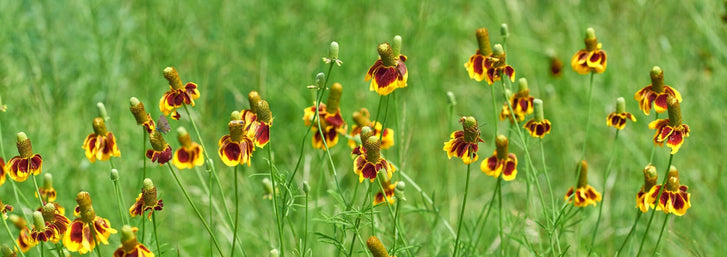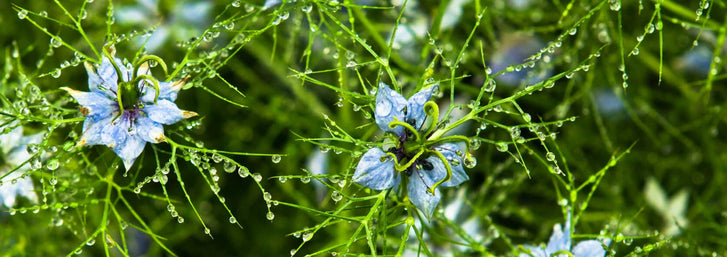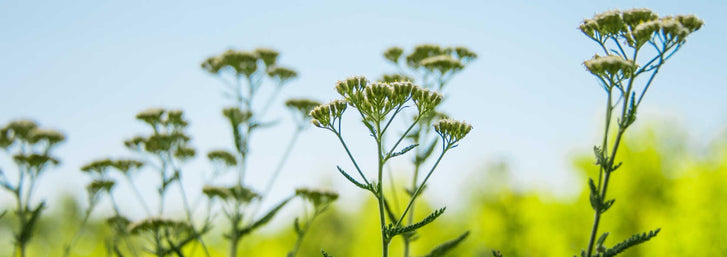
Kat Jones

Mother Nature has an impressive arsenal of natural herbs to use for medicinal purposes and/or to add flavor to meals. Simply put, a herb is any type of plant whose leaves, roots, flowers, berries, stems or seeds that are used for medicine, flavoring, or food. Handled properly, these herbs have a wide range of benefits for people.
Whether by instinct or observation, herbal use has existed for centuries to combat illnesses. Popularity increased over recent years as more people learned of the benefits to using herbs rather than prescription drugs. However, few people realize that most prescription medications are also derived from the use of herbs. Prescription drugs approved by a regulatory agency are generally safe but can wreak havoc on hormones and the body’s natural inclination to heal itself. Herbs are known to work with, rather than against, the body’s natural systems.
Herbs have many benefits for the body when used correctly. Many of these benefits include herbs that function to stimulate, sedate, nourish, and heal the body.
Whether medicinal or culinary, herbs are available for purchase and consumption in a variety of forms. The benefits of these natural substances come in capsules, leaves, teas, and other forms sold in supermarkets, online stores, and herbal retail stores.
Herbs with Medicinal Properties That Stimulate or Sedate - Herbs with medicinal properties have a lot to offer those who consume them on a regular basis. However, no one should use herbs without receiving a proper diagnosis for a health condition. Benefits to using them for medicinal purposes is lost if new illnesses arise or current conditions get worse.
Echinacea: Immune System Stimulant - Echinacea is known to help the immune system fight against the flu, colds and other types of infections. In less common cases, this herb is also used for stimulating the healing of inflamed skin conditions such as wounds and acne.
Parts of the Echinacea plant and roots are used to extract the potency of the herb. This herb can thrive in most gardens before it is squeezed for juice or used fresh for teas. Studies vary on the benefits of using Echinacea to treat respiratory tract infections.
German Chamomile: An Herbal Tension Relief - Experts suggest using whole, dried chamomile flowers for the best results. Studies show that this herb is most effective when used for gastrointestinal conditions and stomach pains. As a natural sedative, chamomile is generally safe for consumption. Anyone who is allergic to ragweed may need to avoid it.
Valerian: Tranquilizer and Sleep Aid Benefits - History runs deep for the usage of valerian as a herb to help with sleeping disorders. The native plant for valerian is found in Asia and Europe where it has been used since ancient Greece. This herb is also known to treat other conditions such as depression, headaches, trembling, and an irregular heartbeat.
To avoid dependency on this herb, recommendations are to take valerian for less than a month. Consumption should not exceed the recommended dosage that can come in a capsule or tablet form.
Benefits of Nourishing Herbs - Just as the name implies, nourishing herbs have tremendous benefits for the human body. Commonly known as the safest herbs in nature, nourishing herbs are typically leafy and very nutritious. Just like leafy green vegetables, herbs in this category provide nutritional benefits through human consumption.
These are herbs that usually can be consumed daily for extended periods of time. Examples of these herbs include milk thistle, burdock, feverfew, and lemon balm.
Milk Thistle: The Mediterranean Healer - Also known as silymarin, milk thistle is a flowery herb found in the Mediterranean and has been used for thousands of years. Milk thistle leaves can be sautéed or steamed and is commonly believed to treat ailments such as liver problems.
It is believed that milk thistle acts as a healing agent to improve functions of the liver. Ailments such as inflammation, cirrhosis of the liver, and disorders with the gallbladder are treated with this herb.
Other conditions are known to improve after using this herb. Some of these included lower cholesterol; reduced growth of breast, prostate and cancer cells; and, a reduction in insulin resistance in type 2 diabetes patients with liver cirrhosis.
Burdock: Purifying Properties - Burdock is an herbal wild plant that is known for its purifying properties. Valuable for treating eczema and other skin conditions, the medicinal properties in burdock is safe and effective. Adult acne is no match for the properties found on burdock when consumed as a strong tea. Used in drops from burdock root or seed, a slow steady improvement is noticeable with daily consumption.
For some, burdock also has significance when mixed in soups and salads. The root properties make a strong herbal tea. The leaves can be cooked like other leafy green vegetables.
Feverfew: The Mediator of Migraines - Feverfew is a medicinal herbal substance originally found in Eastern Europe. These short, daisy-like flowers of this herbal substance grow in other areas such as South and North America.
For centuries, feverfew is an herbal healer for headaches, migraines and as a fever reducer. For centuries, humanity has realized the medicinal properties in feverfew to help women during childbirth, menstruation, and infertility. Other conditions this herbal substance is known for include toothaches, rheumatoid arthritis insect bites, and stomach aches. The benefits of this herbal substance continue as more research reveals other conditions to treat. People who suffer from allergies, psoriasis, and asthma can receive the benefits of feverfew with regular consumption.
Feverfew leaves can be eaten fresh to combat some of these conditions. The stems, flowers, and dried leaves are used occasionally to make supplements. These herbal forms might include tablets, liquid extracts, and capsules.
Lemon Balm: Another Herbal Healer - A variety of lemon forms are known for healing properties as well as flavoring foods. As a stimulant and a sedative, lemon balm is probably one of the most versatile herbs in the natural garden. Lemon balm is another herbal healer that can be used to stimulate bodily organs such as the heart. It can also calm anxiety.
Herbs with Medicinal Properties for Illnesses - Along with medicinal uses, herbs have played a significant part in many cultural practices. These include embalming, religious rituals, and treating illnesses. The medicinal properties of herbs have roots in many ancient civilizations across Europe, Africa, and China. Western culture is still catching up to what has been a normal tradition in other parts of the world. Many people continue to rely on the medicinal properties of herbs for a variety of conditions.
Baikal skullcap - is a medicinal herb commonly used in Chinese medicinal culture. The medicinal properties in Baikal skullcap are used in this part of the world to treat a wide variety of issues. These may include shingles, hypertension, colds, headaches, fevers, and hepatitis.
Astralagus is another traditional Chinese medicinal herb consumed in capsule or extract form. It is also used in teas, soups and combined with other medicinal herbs to support the immune system. The common cold and other upper respiratory infections are treated with this herbal substance. Chinese culture embraces the medicinal benefits in Astralagus as part of cancer therapy and chronic hepatitis.
Yarrow - is a medicinal remedy that has the reputation of treating many conditions. Yarrow works as a partner to the body’s natural medicinal abilities by improving the digestive system. Blood circulation is also improved with the use of this herbal medicine. It also supports the kidneys, gall bladder, and certain liver functions. As an herbal tea, yarrow helps to regulate a woman’s menstrual cycle. Additionally, women who experience premenstrual symptoms can benefit from drinking the herbal form of yarrow.
St. John’s wort - comes from ancient Greek practices. Properties in St. John’s wort have healing properties to cure insect bites, wounds and burns. Some cultures also take advantage if its properties for curing malaria.
Medicinal properties found in St. John’s wort can also help with mental conditions. People who suffer from depression or certain mood disorders can use this medicinal plant to control symptoms. Prolonged use may contribute to other conditions such as developing sensitivity to sunlight.
Herbs with Spice and Everything Nice - The benefits of herbal substances extend beyond medicinal purposes. Many people can also enjoy flavorful foods with the right combination of fresh herbs. This is a common practice all over the world when people want to spice things up by adding herbal ingredients to common dishes.
The places where these herbal ingredients are found vary just as much as the usage. Found in the Caribbean, Mediterranean countries, the Middle East, Greece, and South Asia, many herbs are used to boost flavor. Meat, pasta and vegetable dishes enjoy the benefits of a savory aroma to many household dishes.
Savory treats are enhanced by using herbal spices such as thyme, cilantro, basil, oregano andchives.
Authentic flavors from abroad are captured in private kitchens. Families realize that herbal properties not only heal, but also add zing to the palate.
Use Herbal Substances Wisely - Appreciating the many benefits of using herbal substances require understanding how to use them. The best advantage comes with not only knowing the benefits, but in also being cautious when using the herbal garden. Many herbal substances have potent properties that can help to improve or prevent health conditions. Likewise, these same properties have the potential of being toxic if not used correctly.
Consuming too much herbal substances can produce unwanted side effects. Where some can heal body organs, others can cause damage if consumed excessively. Therefore, it is important to receive the proper diagnosis before taking certain herbs. Following directions for consumption will improve the medicinal benefits of taking nature's natural medicinal ingredients and allowing the body to heal naturally.
Leave a comment
Your email address will not be published. Required fields are marked *
0 Comments
No Comments yet! Be the first to start a conversation
Further Reading

10 Natives of the Southwest USA for Pest Control
Written By Lara Wadsworth The Southwestern United States is a region incredibly unique to the rest of the country. The hot, dry weather can be challenging for plants and animals to thrive without additional help. That is why gardening with natives can ...

Ashleigh Smith
2024-04-157 min read0
Spring Into Action - Celebrating Earth Day
Written By Chelsea Hafer Spring is quickly arriving, and that means that Earth Day is near! Earth Day is the perfect occasion to appreciate our wonderful planet and all that it does for us and think of ways you can give back to it. In this blog post, w...

Ashleigh Smith
2024-04-154 min read0
Everything You Need To Know About Rain Gardens
Written By Lara Wadsworth Rain gardens are quickly gaining popularity for their perfect marriage of utility and beauty. What simply looks like a beautifully landscaped garden is actually a native habitat that serves as a storm drain and water sponge. B...

Ashleigh Smith
2024-04-085 min read1
Northeastern Natives for Attracting Beneficial Insects
Written By Lara Wadsworth The Northeastern United States is rich with American history, but did you also know that it is rich in plant biodiversity? Nature has learned through time how to work in harmony with the various species that attempt to thrive....

Ashleigh Smith
2024-04-086 min read1



